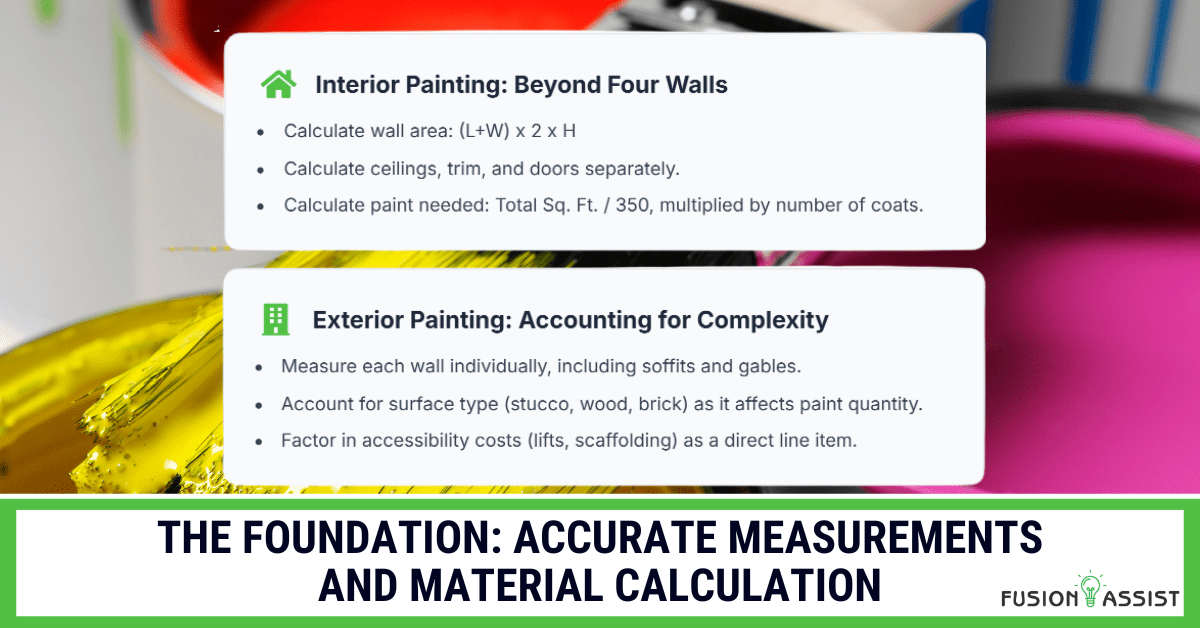Introduction
You can be booked out months and have a crew that is working 24-7, and at the end of the quarter, you look at the bank account and wonder where did the money disappear. One of the most disheartening aspects of the trades comes with the sense of working without pay even when you are busy.The estimate is nearly always the answer. A bid that is poorly calculated, i.e. that underbids on prep work, mis-estimates materials or does not take into consideration the actual business costs is a surety that you are leaving money on the table.
This book is meant to prevent the holes in your financial bucket. We are not stopping at simple estimations, but we are providing a business-oriented system of painting job estimates. That is how best-in-class painting firms approach the process of ensuring that every job they secure is not another project to be completed, but another opportunity to profitably grow a viable business.
The Foundation: Accurate Measurements and Material Calculation

The basis of a profitable estimate is precision. The first step to working at a loss is the so-called “guesstimation” of the size of a room or the quantity of paint required. A professional is systematic on measuring all the surfaces.
Interior Painting: Beyond the Four Walls
An interior project is a combination of independent surfaces, each of which has to be calculated separately and taken into account. Getting painting job estimates right for interior work depends on breaking down every surface and component into measurable units.
- Calculating Wall Area: Your beginning point is the simple formula: ( Room length + Room width ) x 2 x Ceiling Height = Total square footage of wall. In a 12×15 room that is 8 feet high, this would be 12 +15 x2 x 8 = 432 sq. ft.
- Subtracting Openings (The Right Way): It is tempting to just leave the windows and doors out, but, on a wall with large openings (such as a picture window or a pair of patio doors) you should subtract them. But on common doors and windows the time consumed in cutting in around them usually more than offsets the paint saving, and many professionals do not deduct it. Be a judge to yourself.
- Ceilings, Trim, and Doors: Estimates of these have to be calculated as a separate line item. They require a different paint and labor needs are very different as compared to rolling walls.
- Ceilings: Length of room x Width of a room.
- Trim: Take a measurement of all the linear feet of the baseboards, window casings and crown molding.
- Doors: Price per door. A flat, hollow-core door is more quickly painted as compared to a detailed, six-panel solid wood door. Sell them at their price.
- Calculating Paint Quantity: This is calculated by dividing the total square feet by 350 to give the amount of gallons of paint to be used. (The majority of gallons can cover 350-400 sq. ft.). Importantly, you will then have to multiply this by the amount of coats you need. A dramatic transformation of color might need a primer coat and two topcoats. Always figure on two coats at least in order to have a good finish.
Exterior Painting: Accounting for Complexity
Repainting the outside brings a twist to the estimation. That’s why painting job estimates for exteriors must factor in variable surfaces, access equipment, and material variations.
- Calculating Surface Area: In the case of an easy rectangular house, a variation of the interior formula may be used. In case of a complex architecture, each wall could be measured separately (Width x Height) and then added. Do not overlook soffits, fascia and gables.
- Surface Type Matters: The substance will determine the preparation and the kind and volume of paint to be utilized. Wood siding is not estimated the same as stucco, brick or vinyl. Old brick or dry wood surfaces have porous surfaces and will absorb a great deal more paint and primer than a pre-painted surface.
- Accessibility is a Direct Cost: Will you be able to paint the entire house by using ladders or do you have to rent a boom lift or build scaffolding? You have to clearly state the cost of this equipment together with the delivery and installation time. Not doing it can cost you thousands of money.
The Hidden Profit Killer: Underestimating Prep and Labor
And this is the one worst thing about painting businesses, and this is what makes them go down the drain, they sell the paint, and they give the labor away. Accurate painting job estimates determines the quality of a paint job. It is also the most labor intensive and time consuming component of the project. You would be making a loss in case you are not selling it at the right price.
A Comprehensive Prep Work Checklist (The Most Important Step)
It is not that prep work is optional and it cannot be free. The time of doing these tasks should appear in your estimation. To achieve a high-quality exterior repaint this consists of:
- Power Washing: To use to clean dirt, grime and chalking paint.
- Scraping and Sanding: In order to eliminate loose and failing paint.
- Caulking: Caulking all cracks and gaps so as to make it weatherproof.
- Masking and Covering: Sheltering the windows, lighting, roofing and landscaping.
- Priming: Using either a spot primer on bare wood or a full primer coat in the case of any key change of surface or color.
The time has to be charged. You can simply factor it into your total square-foot price (assuming that it is not priced as low as your competitors) or you can have it as an additional line item: Surface Preparation. The latter is more open and it will assist in educating the client about the value that you offer.
Calculating Labor Hours Accurately
Your biggest expense is your labor cost. The accurate estimate of labor is not a negotiable item.
- Establish Your Production Rates: This is the surface that an average painter can cover, in an hour, in terms of production rate. This is different per method of application:
- Brushing/Rolling: A conventional wall takes 100-150 sq. ft. per hour.
- Spraying: 400-500 sq. ft. per hour (but remember to add time for masking and back-rolling).
- Detailed Trim Work: Measured in linear feet per hour, and it’s much slower.
- Variables That Impact Speed: The actual speed should be modified depending on the conditions in the job site.
- Are the building walls rough or smooth?
- What is the amount of work (cut-ins) needed?
- Do you paint occupied areas and do you move furniture?
- How competent is the crew allocated?
- Don’t Forget Your Overhead and Profit (The O&P Factor): The business Math that makes the difference between the professionals and the amateurs.
- Overhead: You need to figure out all your business costs that are NOT job related (insurance, marketing, truck payments, office rent, your salary). Divide this with your annual working hours to obtain your hourly overhead cost. This expenses should be factored in each hour you charge.
- Profit: Choose the profit margin you want (e.g. 20 percent). Once you have calculated the cost of the job (materials + labor + overhead) you add your margin of profit to this amount. This is your pay off of your risk of being in business.
Fusion Assist Spotlight: The Painter’s Secret Weapon

To a busy painting contractor time is money. Each hour you spend crouching over a pair of blueprints or measuring something with a tape measure by hand, is an hour that you are not in control of your workforce, greeting new customers, or strategizing the expansion of your company. Fusion Assist is the secret weapon that the painter has when it comes to painting job estimates because the tedious and time-consuming process has been taken care of with greater speed and accuracy.
From Blueprint to Bid in 24 Hours
Suppose that there is an auction of a new construction tract of 20 houses. Figuring out the paintable surface area, trim footage, and the number of materials of each one of them manually would require days. Using the Fusion Assist, it is easy. You send us the architectural plans and our certified estimators take this information and perform a detailed take off using state of the art software. We will offer you a full bid package which consists of:
- The amount of square footage of all ceilings and walls.
- Summation of linear distance of all trim.
- A full listing of the material, right up to how many gallons of paint, rolls of tape, and tubes of caulk.
- An hour to hour estimate of labor.
Win Bigger Commercial and Residential Projects
We do not only provide services in new construction. An estimate produced by Fusion Assist enables you to secure large-scale commercial repaints and high end residential jobs. Giving a client a detailed and open bid with the scope and cost clearly described will show a degree of professionalism that will immediately instill trust in the client and put you a league ahead of competitors with a single line quote. This is a key strategy for winning more construction bids and scaling your contracting business.
Case Study: Exterior Repaint of a Commercial Building
Client
A commercial painting contractor, Midwest.
Challenge
The contractor was called to give a quote on the total exterior repaint of a three story office building. The project consisted of two types of substrate (brick and EIFS) and involved a lot of pre-work and the need to access the job with a boom lift. The property manager needed a very detailed bid by the close of the week and the contractor did not have time to do a full manual measurement and takeoff.
Fusion Assist Solution
Our contractor provided us with a copy of architectural drawings and some photographs of the existing statuses. Our team did a full surface area takeoff using a combination of the plans and the aerial imagery and distinguished between the square footage of the brick (which required a special sealer) and the EIFS (which required a special elastomeric coating). We have determined the precise amounts of paint needed per surface, stated how much time we needed to rent a 60-foot boom lift, and estimated the labor time of power washing, preparation, and painting.
Result
It took us two days to provide the thorough estimate. The contractor who had made the most professional and complete bid won the project over two other competitors that were larger and more established but slower to react. The property manager used clarity and detail of the bid as the differentiating factor.
Conclusion: Paint a Brighter Future for Your Business
Your estimate is the most useful business weapon you have. It is not just a price, not only a project plan, not even a promise to your client, but a promise to yourself, a contract, to have a profitable company. Once you learn how to estimate, you will quit competing on price and start competing on professionalism, transparency and value. It is you who gets control of your profitability and starts developing a business with a sunny and sustainable future.
Spend more time leading your crew and less time wrestling with paperwork. Let Fusion Assist handle your painting job estimates. Get a free quote on your next project! Contact us today
Frequently Asked Questions (FAQs)
What is a good base price per square foot to paint interior?
Although this can change dramatically depending on location, the cost of the average interior repaint (two coats on the walls) by a professional painter can be approximately between 2.00 and 4.00 dollars per square foot of floor space. Pricing based on surface area is however more precise. A final price should never be given until the job has been seen, prep work, trim and ceilings considered.
Does high ceiling or places that are hard to reach require an added fee?
Absolutely. Where more than a normal stepladder is necessary (vaulted ceilings, stairwells, or places requiring scaffolding or a lift) the production rates are greatly reduced. They must always have a higher labor rate to compensate time and risk.
What do I do with requests of change orders during the project?
The written change order form should always be used. In case a client comes up with additional scope of work or a change in color after the project has begun, and add the new scope of work and the price difference. Before you take up the new work have the client sign it. This guards you against conflicts and guarantees that you are compensated of the additional work.
Which is the most suitable piece of software painters can use to estimate?
A simple spreadsheet can be used by a single operator. Nevertheless, professional takeoffs of blueprints are done using specialised software, such as Planswift or Bluebeam. This is the kind of program the professional estimating services such as Fusion Assist use to be accurate. For business practices, resources from the Painting Contractors Association (PCA) can be invaluable.
How can I factor in the variations of paint sheen (flat, and eggshell and semi-gloss) in my estimate?
The sheen alone does not have a radical impact on the cost of the paint, but it may have an impact on the labor. Less forgiving and visibly revealing imperfections are glossier type of paint (such as semi-gloss on trim). They can also typically necessitate a more careful preparation work along with greater skill to be applied impeccably, and this should be included in your labor calculation.




